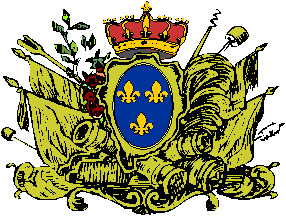When Expédition Particulière arrived at Newport, RI, in summer of 1780, the French were received at first with some trepidation by many of the American colonials. However, the expedition's exceptional discipline and professionalism, as well as their colorful uniforms and regimental flags, quickly became popular. In September 1781, the French, with Washington's main army, conducted a swift strategic movement from the New York area to Virginia. There they were joined by other French expeditionay forces under the command of the marquis de Saint-Simon. The additional regiments were: Agenois, Touraine, Gâtinais, which had been off loaded from the ships of the French Admiral, comte de Grasse.
The overall commander of the French land army was Jean Baptiste Donatien de Vimeur, comte de Rochambeau (1725-1807). He was undoubtedly the main reason for the great success of this force. He held the rank of lieutenant general and had many years of campaigning experience. His skillful leadership and professional wisdom were vital in advising General Washington and in guiding the 'end-game' strategy that implemented the Yorktown Campaign.
|
|
The AmericanRevolution.org web site's 'Scholar's Showcase' has some fine narratives. One addressing the French participation in the American Revolution is: 'France in the Revolution' -- a 26 chapter work by James Breck Perkins.
|
|
A misleading clich� frequently repeated in much of the popular literature on the American Revolution is that the French participation was mainly for �revenge'. For the most part the authors of such statements are journalists or popular history writers. Support for revenge being the principal motive behind French aid to the American War for Independence is usually based upon hearsay and quotes from journals of secondary players, and not from documents that record the decision making that directed the French military and diplomatic actions in 1775-1783.
|
|
The diplomatic background surrounding the French assistance to the American Revolution is well provided by Dr. Jonathan R. Dull, research professor at Yale University. His scholarship provides a rare bulwark against the flood of legendary and clich� infested assertions floating in so many of the general articles and books as to what were the European intentions and responses to the American rebellion. Professor Dull's principal work on the topic is A Diplomatic History of the American Revolution (1985). The bibliography provided for this website [link given above] lists some of his other fine works on the French navy of the era.
|
|
The Hudson River Valley History site contains a wealth of detail on American Revolution events in that region. The site also provides links to access and download pdf format files of Dr. Robert A. Selig's historical and architectural surveys of the "Washington - Rochambeau Revolutionary Route (1781-1782)" for various states such as New York, Connecticut, Delaware, New Jersey, and Pennsylvania: |
|
The US Library of Congress offers online access to its �The Rochambeau Map Collection' at http://memory.loc.gov/ammem/collections/rochambeau-maps/ The The Rochambeau Map Collection contains cartographic items used by General comte de Rochambeau when he commanded the French expeditionary army (1780-82) during the American Revolution. The maps were from Rochambeau's personal collection, cover much of eastern North America, and date from 1717 to 1795. The maps show Revolutionary-era military actions, some of which were published in England and France, and early state maps from the 1790s. The collection show the importance of cartographic materials in the campaigns of the American Revolution as well as Rochambeau's continuing interest in the new United States. The collection consists of 40 manuscript and 26 printed maps which are in the Library of Congress' Geography and Map Division.
Within this collection are some maps made by Lafayette's cartographer M. Capitaine du Chesnoy. At present the means to access particular maps in this collection is to use the �Keyword' search option. For example: entering Lafayette and Barren Hill will provide a list of links, the top one taking the viewer to a maps of the 28 May 1778 maneuvers executed at that location. A related website is one the US Library of Congress has conceived in partnership with France's national library, the Biblioth�que nationale de France, France in America /France en Am�rique is a bilingual digital library made available by the Library of Congress. It explores the history of the French presence in North America from the first decades of the 16th century to the end of the 19th century. The URL is http://international.loc.gov/intldl/fiahtml/ Con�u en partenariat avec la Biblioth�que nationale de France, La France en Am�rique / France in America est une biblioth�que num�rique bilingue de la Biblioth�que du Congr�s. Elle explore l'histoire de la pr�sence fran�aise en Am�rique du Nord des premi�res d�cennies du XVIe si�cle � la fin du XIXe si�cle. |
|
Links to French websites: Though mostly in French, these sites are very friendly to Anglophone visitors. Try them out and practice your French!
|
|
Special temporary announcements:
can be be found by Clicking Here. |
|
International Celebration of the 225th Anniversary of "The Peace Treaties Signed at Paris and Versailles on 3 September 1783" Click here for information on ceremonies conducted in France during September 2008.. |
Expédition Particulière Commemorative Cantonment Society,
PO Box 137, Mount Vernon, VA 22121.
Comments and questions are welcomed, and can be e-mailed to:
|
 |
Return to Durfée page |

